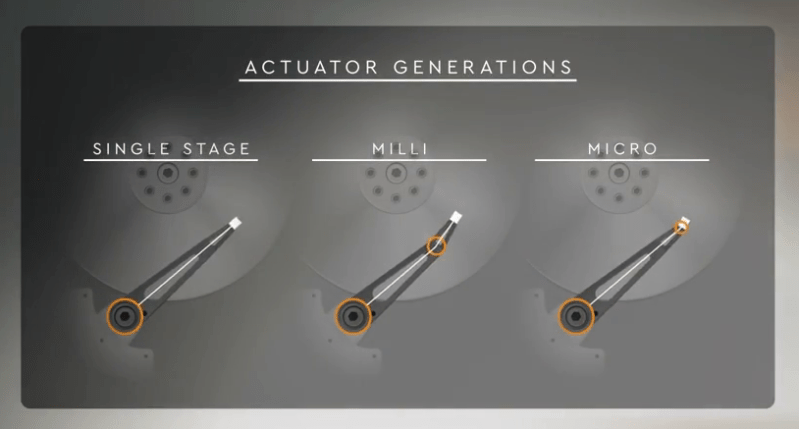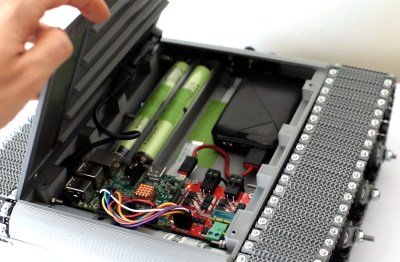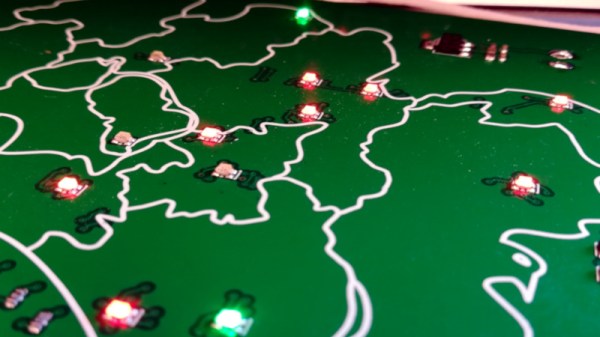Here at Hackaday we’re privileged to be part of a global community of hackers, makers, technology enthusiasts and creative people whose collective works make our daily news feeds such a fascinating read. We encounter you all directly in the physical world rather the virtual one at the many events across the community, or at the various hackerspaces we visit on our travels. But how can we keep track of the world of hackerspaces when there are so many? Maybe SpaceAPI might hold the answer.
Hackaday Podcast 123: Radioactive Rhinos, Wile E. Coyote Jetpack, Radio Hacks 3-Ways, And Battery Welders On The Spot
Hackaday’s Mike Szczys is taking a bit of vacation this week, so Elliot is joined by Staff Writer Dan Maloney to talk about all the cool hacks and great articles that turned up this week. Things were busy, so there was plenty to choose from, but how would we not pick one that centers around strapping a jet engine to your back to rollerskate without all that pesky exercise? And what about a light bulb that plays Doom – with a little help, of course. We’ll check out decals you can make yourself and why the custom keyboard crowd might want to learn that skill, learn about the other “first computer”, and learn how a little radiation might be just what it takes to save an endangered species.
Take a look at the links below if you want to follow along, and as always, tell us what you think about this episode in the comments!
Direct download (55 MB or so.)
Places to follow Hackaday podcasts:
LED Matrix Glasses Built With The Help Of Graph Paper
These days, there’s all manner of addressable LEDs out there that can be easily used to produce blinky, flashy projects. However, there’s nothing stopping makers from doing things the old fashioned way, and hacking together an matrix out of raw LEDs. [Deepak Khatri] did just that with his own custom build.
Rather than rely on a PCB or other substrate to hold the matrix together, [Deepak] elected to freeform the design instead. A matrix of holes was cut in a cardboard template with the aid of graph paper. LEDs were then inserted into the holes in the requisite pattern, and their own leads soldered together to create the frame for the glasses. Additional wires that were needed were then installed, doubling as a bridge to allow the glasses to rest comfortably on the nose. Black epoxy was then used on the back side to block the light from blinding the wearer. The matrix is controlled by a pair of shift registers addressed by a microcontroller, and the display animates impressively smoothly.
it’s a fun build, and one that we suspect looks particularly impressive at night. They’d also make it easy for your friends to spot you in a dark club. We’ve seen some impressively stylish LED glasses over the years, too, dating all the way back to [macetech]’s pair from 2012. Video after the break.
Continue reading “LED Matrix Glasses Built With The Help Of Graph Paper”
This Week In Security: Updates, Leaks, Hacking Old Hardware, And Making New
First off, Apple has issued an update for some very old devices. Well, vintage 2013, but that’s a long time in cell-phone years. Fixed are a trio of vulnerabilities, two of which are reported to be exploited in the wild. CVE-2021-30761 and CVE-2021-30762 are both flaws in Webkit, allowing for arbitrary code execution upon visiting a malicious website.
The third bug fixed is a very interesting one, CVE-2021-30737, memory corruption in the ASN.1 decoder. ASN.1 is a serialization format, used in a bunch of different crypto and telecom protocols, like the PKCS key exchange protocols. This bug was reported by [xerub], who showed off an attack against locked iPhone immediately after boot. Need to break into an old iPhone? Looks like there’s an exploit for that now. Continue reading “This Week In Security: Updates, Leaks, Hacking Old Hardware, And Making New”
Mistaken Identity — Piezo Actuators Not Test Pads
One hard disk recently failed in the EEVBlog laboratory’s NAS. Keeping true to his catch phrase, [Dave “Tear it Apart” Jones] opened it up and gave us an inside tour of a modern hard disk drive. There are so many technological wonders to behold in modern HDDs these days — the mechanical design, electronics and magnetics, and the signal processing itself which is basically an advanced RF receiver — that we can forgive [Dave] for glossing over a system of piezo actuators thinking they were manufacturing test points. Even knowing they are actuators, you have to stare at them and think for a bit before your brain accepts it.
Later realizing the mistake, he made a follow-up video (down below) focusing on just the disk head actuator arms and this micro-actuation system (or perhaps they are milli-actuators). The basic concept is a pair of piezoelectric transducers mounted on either side of the short arm holding the read head. Presumably they are driven out of phase to flex the arm left or right, but the motion is imperceptible to the eye — even under magnification, [Dave] was not able to discern any motion when he pulsed the transducers. When you consider that these micro-actuators are mounted on the main actuator arm, which itself is also in motion, the nested control loop arrangement to maintain nanometers of accuracy is truly amazing. Check out this 45 second explanatory video by Western Digital which has a good animation of the concept.

If you want to see your HDD in operation without taking it apart, check out the transparent drive we wrote about last month. And to read more about esoteric actuators, check out this article from 2015 which contains one of the longest words to appear in our pages — magnetorheological. If you’ve experience a hard disk failure, which thankfully is becoming rarer these days, do you chunk it or tear it apart?
Continue reading “Mistaken Identity — Piezo Actuators Not Test Pads”
Blowing A 5000 A Fuse Takes Some Doing
Fuses are generally there to stop excessive electrical currents from damaging equipment or people’s soft, fleshy bodies when faults occur. However, some people like to blow them just for fun, and [Photonicinduction] is just one of those people. He recently decided to push the boat out, setting his mind to the task of popping a 5000 A fuse in his own back yard. (Video, embedded below.)

It’s not a job for the faint-hearted. The fuse is rated at 5,000 A — that’s the nominal rating for the currents at which it is intended to operate. Based on the datasheet, the part in question is capable of withstanding 30,000 A for up to five full seconds. To pop the fuse instantly takes something in the realm of 200,000 A.
To achieve this mighty current, a capacitor bank was built to dump a huge amount of energy through the fuse. Built out of ten individual capacitor units wired up in parallel, the total bank comes in at 10,000 μF, and is capable of delivering 200,000 A at 3000 V. (Just not for very long.) The bank was switched into circuit with the fuse via a pneumatic switch rated at just 12,000 A.
The results are ferocious, with both the fuse and switch contacts blasting out hot metal and flashes of light when the power is dumped. It’s a heck of a display. We’ve featured big capacitor banks before too, though they pale in comparison to what we’ve seen here today.
Scratch Built Tracked Robot Reporting For Duty
Inspired by battle-hardened military robots, [Engineering Juice] wanted to build his own remote controlled rover that could deliver live video from the front lines. But rather than use an off-the-shelf tracked robot chassis, he decided to design and 3D print the whole thing from scratch. While the final product might not be bullet proof, it certainly doesn’t seem to have any trouble traveling through sand and other rough terrain.
Certainly the most impressive aspect of this project is the roller chain track and suspension system, which consists of more than 200 individual printed parts, fasteners, bearings, and linkages. Initially, [Engineering Juice] came up with a less complex suspension system for the robot, but unfortunately it had a tendency to bind up during testing. However the new and improved design, which uses four articulated wheels on each side, provides an impressive balance between speed and off-road capability.
 Internally there’s a Raspberry Pi 4 paired with an L298 dual H-bridge controller board to drive the heavy duty gear motors. While the Pi is running off of a standard USB power bank, the drive motors are supplied by a custom 18650 battery pack utilizing a 3D printed frame to protect and secure the cells. A commercial night vision camera solution that connects to the Pi’s CSI header is mounted in the front, with live video being broadcast back to the operator over WiFi.
Internally there’s a Raspberry Pi 4 paired with an L298 dual H-bridge controller board to drive the heavy duty gear motors. While the Pi is running off of a standard USB power bank, the drive motors are supplied by a custom 18650 battery pack utilizing a 3D printed frame to protect and secure the cells. A commercial night vision camera solution that connects to the Pi’s CSI header is mounted in the front, with live video being broadcast back to the operator over WiFi.
To actually control the bot, [Engineering Juice] has come up with a Node-RED GUI that’s well suited to a smartphone’s touch screen. Of course with all the power and flexibility of the Raspberry Pi, you could come up with whatever sort of control scheme you wanted. Or perhaps even go all in and make it autonomous. It looks like there’s still plenty of space inside the robot for additional hardware and sensors, so we’re interested to see where things go from here.
Got a rover project in mind that doesn’t need the all-terrain capability offered by tracks? A couple of used “hoverboards” can easily be commandeered to create a surprisingly powerful wheeled platform to use as a base.
Continue reading “Scratch Built Tracked Robot Reporting For Duty”

















